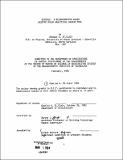| dc.contributor.advisor | Harvey J. Bryan. | en_US |
| dc.contributor.author | St. Clair, Charles A | en_US |
| dc.contributor.other | Massachusetts Institute of Technology. Dept. of Architecture. | en_US |
| dc.date.accessioned | 2013-03-01T14:46:30Z | |
| dc.date.available | 2013-03-01T14:46:30Z | |
| dc.date.copyright | 1984 | en_US |
| dc.date.issued | 1984 | en_US |
| dc.identifier.uri | http://hdl.handle.net/1721.1/77300 | |
| dc.description | Thesis (M.S.)--Massachusetts Institute of Technology, Dept. of Architecture, 1984. | en_US |
| dc.description | MICROFICHE COPY AVAILABLE IN ARCHIVES AND ROTCH. | en_US |
| dc.description | Includes bibliographical references (leaves 67-68). | en_US |
| dc.description.abstract | Social and economic pressures are causing architectural designers to resume their responsibility to consider the effects that design decisions will have on the thermal performance of buildings. Recent studies have shown that conservation techniques and passive solar design are the two most cost effective strategies for reducing the energy costs of buildings. Although much research has been done in energy conserving techniques, many designers have been unable to implement these strategies because they do not have a means of evaluating the thermal performance of a building during the design process. Several analytical tools have been developed but they are usually complex computer programs that many designers find too cumbersome, time consuming, and expensive to use in the design process. The use of analytical methods as design tools is discussed, stressing that designers should use them more as educational tools to gain a clear understanding of the principles involved so that thermal aspects of buildings will intuitively be included in their thinking during the design process. QUIKPAS is a microcomputer program that accurately models the thermal performance of buildings, asking for information and giving results in a manner that is conducive to the internalization process which will allow a designer to integrate the thermal aspects of buildings into his or her designs. A comprehensive discussion of the features of QUIKPAS is given. | en_US |
| dc.description.statementofresponsibility | by Charles A. St. Clair. | en_US |
| dc.format.extent | 68 leaves | en_US |
| dc.language.iso | eng | en_US |
| dc.publisher | Massachusetts Institute of Technology | en_US |
| dc.rights | M.I.T. theses are protected by
copyright. They may be viewed from this source for any purpose, but
reproduction or distribution in any format is prohibited without written
permission. See provided URL for inquiries about permission. | en_US |
| dc.rights.uri | http://dspace.mit.edu/handle/1721.1/7582 | en_US |
| dc.subject | Architecture. | en_US |
| dc.title | QUIKPAS : a microcomputer based passive solar analytical design tool | en_US |
| dc.title.alternative | Microcomputer based passive solar analytical design tool | en_US |
| dc.type | Thesis | en_US |
| dc.description.degree | M.S. | en_US |
| dc.contributor.department | Massachusetts Institute of Technology. Department of Architecture | |
| dc.identifier.oclc | 12098643 | en_US |
